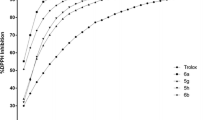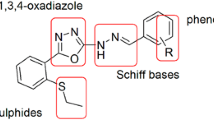Abstract
The practice of medicinal chemistry is devoted to the discovery and development of new agents for treating disease. A new derivative of methyl 2-((E)-3-(3,4-dihydroxyphenyl)acrylamido)benzoate 2 was synthesized by reacting the amino group of methyl anthranilate 1 with caffeic acid in the presence of PCl3. Cyclcondensation of 2 with hydrazine hydrate afforded the corresponding 2,3-dihydro-2-(3,4-dihydroxyphenyl) pyrazolo[5,1-b]quinazolin-9(1H)-one 3. The median lethal doses (LD50s) of compounds 2 and 3 in mice were 1,135 and 495 mg/kg b.w., respectively. The anti-inflammatory, reducing power, chelating activity on Fe2+, free radical-scavenging, and total antioxidant activities were more pronounced in compound 2 compared to compound 3. On the other hand, antipyretic activity was more pronounced in compound 3 compared to compound 2. Antioxidant activity of compounds 2 and 3 increased with increased concentrations. Total antioxidant activity of compounds 2, 3 and both standards decreased in the order of α-tocopherol > compound 2 > trolox > BHA > BHT > compound 3. Administration of compounds 2 and 3 orally to the rats at dose of 50, 100, and 150 mg/kg b.w., for 10 days showed non-significant changes in serum level of GOT, GPT, ALP, γ-GT, and LDH as compared with the control group. In addition, oral administration of the compound 2 at a concentration of 100 and 150 mg/kg b.w. and compound 3 at a concentration of 150 mg/kg b.w. daily to normal rats for 10 days showed a significant increase in liver GSH, GPx, GR, and GST activities and significant decrease in TBARS level. But, administration of diclofenac sodium (30 mg/kg b.w.) orally to the rats daily for 10 days to rats showed significant increase in serum SGOT, SGPT, ALP, γ-GT, and LDH and significant decrease in liver GSH, GPx, GR, and GST activities. These findings suggest that compounds 2 and 3 exhibited good antioxidant and anti-inflammatory activity and also showed effects on liver enzymes.







Similar content being viewed by others
References
Abdel-Rahman AE, Bakhite EA, Al-Taifi EA (2003) Synthesis and antimicrobial testing of some new S-substituted-thiopyridines, thienopyridines, pyridothienopyrimidines and pyridothienotriazines. Pharmazie 58:372–377
Baumann J, Wurn G, Bruchlausen FV (1979) Prostaglandin synthase inhibiting O2-radical scavenging properties of some flavonoids and related phenolic compounds. N-Ss Arch Pharmacol 308:R27–R39
Bendini A, Cerretani L, Carrasco-Pancorbo A, Gómez-Caravaca AM, Segura-Carretero A, Fernández-Gutiérrez A, Lercker G (2007) Phenolic molecules in virgin olive oils: a survey of their sensory properties, health effects, antioxidant activity and analytical methods. An overview of the last decade. Molecules 12:1679–1719
Brand-Williams W, Cuvelier ME, Berset C (1995) Use of a free radical method to evaluate antioxidant activity. Lebensm Wiss Technol 28:25–32
Buhl SN, Jackson KY (1978) Optimal conditions and comparison of lactate dehydrogenase catalysis of the lactate to pyruvate to lactate reactions in human serum at 25, 30 and 37 °C. Clin Chem 2415:828–835
Cao G, Sofic E, Prior RL (1997) Antioxidant and prooxidant behaviour of flavonoids: structure–activity relationships. Free Rad Biol Med 22(5):749–760
Chambhare RV, Khadse BG, Bobde AS, Bahekar RH (2003) Synthesis and preliminary evaluation of some N-[5-(2-furanyl)- 2-methyl-4-oxo-4H-thieno[2,3-d]pyrimidin-3-yl]-carboxamide and 3-substituted-5-(2-furanyl)-2-methyl-3H-thieno [2,3-d]pyrimidin-4-ones as antimicrobial agents. Eur J Med Chem 38:89–100
Chung Y, Chen S, Hsu C, Chang C, Chou S (2005) Studies on the antioxidative activity of Graptopetalum paraguayense E. Walther. Food Chem 91:419–423
Decker EA, Welch B (1990) Role of ferritin as a lipid oxidation catalyst in muscle food. J Agr Food Chem 38:674–683
Fiala S, Fiala AE, Dixon B (1972) Gamma glutamyl transpeptidase in transplantable chemically induced rat hepatomas and spontaneous mouse hepatomas. J Natl Cancer Inst 48:1393–1402
Finney DJ (1964) Statistical methods in biological assay. Charles Griffen and Company Limit, London
Habig WH, Pabst MJ, Jokoby WB (1974) Glutathione-S-transferase. The first enzymatic step in mercapturic acid formation. J Biol Chem 249:7130–7139
Hussein MA (2011) Synthesis and biochemical evaluation of some novel anti-inflammatory quinazolines. Int J Org Bioorg Chem 1:12–20
Hussein MA (2012) Synthesis of some novel triazoloquinazolines and triazinoquinazolines and their evaluation for anti-inflammatory activity. Med Chem Res 21:1876–1886. doi:10.1007/s00044-011-9707-0
Hussein MA, Samir MO (2010) Structure antioxidant activity relationship and free radical scavenging capacity of hesperidin. IJPI’s J Med Chem 1:7–20
Jiang RW, Lau KM, Hon PM, Mak T, Woo K, Fung K (2005) Chemistry and biological activities of caffeic acid derivatives from Salvia miltiorrhiza. Curr Med Chem 12:237–246
King EJ, Armstrong AR (1988) Calcium, phosphorus and phosphate. In: Varley H (ed) Practical clinical biochemistry. CBS, New Delhi, p 458
Lavergne N, Volkman M, Maki JE, Yoder R, Trepanier A (2005) Evaluation of the clinical, immunologic, and biochemical effects of nitroso sulfamethoxazole administration to dogs. Toxicology 208:63–72
Loux JJ, De Palma PD, Yankell SL (1972) Antipyretic testing of aspirin in rats. Toxicol Appl Pharmacol 22:672–675
Lowry OH, Rosebrough NJ, Farr AL, Randall RJ (1951) Protein measurement with the folin phenol reagent. J Biol Chem 193:265–270
Marklund S, Marklund D (1974) Involvement of the superoxide anion radical in the autoxidation of pyrogallol and a convenient assay for superoxide dismutase. Eur J Biochem 47:469–476
Moron MS, Depierre JW, Mannervik B (1979) Levels of glutathione, glutathione reductase and glutathione-S-transferase activities in rat lung and liver. Biochim Biophys Acta 582:67–68
Osawa T, Namiki N (1981) A novel type of antioxidant isolated from leaf wax of Eucalyptus leaves. Agric Biol Chem 45:735–742
Oyaizu M (1986) Studies on products of browning reaction prepared from glucose amine. Jpn J Nutr 44:307–314
Reitman S, Frankel A (1975) A colorimetric method for the determination of serum glutamic oxaloacetic acid and glutamic pyruvic transaminases. Am J Clin Pathol 28:56–62
Rice-Evans CA, Miller NJ, Paganga G (1996) Structure antioxidant activity relationship of flavonoids and phenolic acids. Free Radic Biol Med 20:933–956
Santagati NA, Caruso A, Cutuli VMC, Caccamo F (1995) Synthesis and pharmacological evaluation of thieno[2,3-d]pyrimidin-2,4-dione and 5H-pyrimido [5,4-b]indol-2,4-dione derivatives. II Farmaco 50:689–695
Staal GEJ, Visser J, Veeger C (1969) Purification and properties of glutathione reductase of human erythrocytes. Biochimic Biophysic Acta 185:348
Takashira M, Ohtake Y (1998) A new antioxidative 1,3-benzodioxole from Melissa officinalis. Planta Med 64:555–563
Toda S (2002) Inhibitory effects of phenylpropanoid metabolites on copper-induced protein oxidative modification of mice brain homogenate, in vitro. Biol Trace Elem Res 85:183–188
Uchiyama M, Mihara M (1978) Determination of malondialdehyde precursor in tissues by thiobarbituric acid test. Anal Biochem 86:271–277
Winter CA, Risley EA, Nuss GM (1962) Carrageenin-induced edema in hind paw of the rat as an assay for anti inflammatory drugs. Proc Soc Exp Biol 111:544–550
Yokozawa T, Chen CP, Dong E, Tanaka T, Nonaka GI, Nishioka I (1998) Study on the inhibitory effect of tannins and flavonoids against the 1,1-diphenyl-2-picrylhydrazyl radical. Biochem Pharmacol 56:213–222
Author information
Authors and Affiliations
Corresponding author
Rights and permissions
About this article
Cite this article
Hussein, M.A. Synthesis, anti-inflammatory, and structure antioxidant activity relationship of novel 4-quinazoline. Med Chem Res 22, 4641–4653 (2013). https://doi.org/10.1007/s00044-013-0468-9
Received:
Accepted:
Published:
Issue Date:
DOI: https://doi.org/10.1007/s00044-013-0468-9




